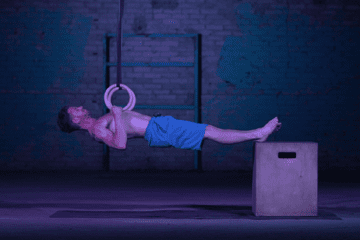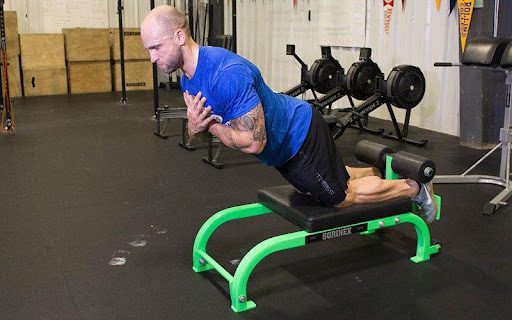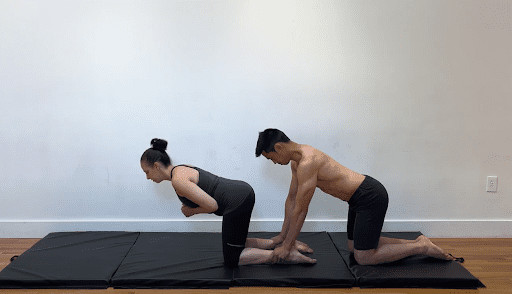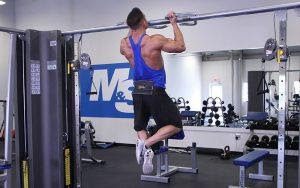
Join the tribe of Movement & Calisthenics Athletes – people just like you that are working with their own body weight to get strength, lose fat build muscle, recover from injuries and live their best lives!
In the world of calisthenics, there are many different exercises that people can do to work out their bodies and reach different goals.🎯
Some of these movements are more popular than others.
Some of these movements are often neglected but shouldn’t be because of the amazing benefits they can offer!😱
In this article, we will discuss five 🖐 of the most underrated calisthenic exercises and why you should be doing them!
✊Training with calisthenics
Calisthenics is bodyweight training. It uses bodyweight to work out the body and is known for its simplicity in terms of equipment that it requires. This means that you can train with calisthenics anywhere, anytime!
Before we talk about the five most underrated calisthenics exercises, let’s start off by talking about why you should opt for calisthenics.
✊Weight training VS calisthenics
Opting for bodyweight training over bodybuilding is a popular choice among many people who want to stay fit and healthy.
Many of the most effective calisthenic exercises are easy on the body, but they can be challenging if you choose the proper progression for you, and it can also be tough for those new to working out with their body weight.
Although weight training offers a more straightforward way to induce progressive overload, calisthenics also has its benefits and can also induce overload through other methods.
🤜These bodyweight workouts can help you improve your range of motion, body coordination, and it can also be a more efficient method for improving overall relative strength than bodybuilding. But you can also build a serious physique with bodyweight training.
You can read more about the calisthenics PROs and CONs in the article below:
Is calisthenics really the best way to train?
Why do we have underrated exercises?🤔
Calisthenics is taking the world by storm. It is more recognized by now by the mainstream fitness industry, but most of the exercises acknowledged are the fundamentals such as :
- ✅ Push-ups
- ✅ Pull-ups
- ✅ Squats
- ✅ Dips
Now there’s nothing wrong with the basics. Basics work.👍
They are the fundamentals of calisthenics and compound exercises that help you develop starting strength. However, these exercises are still not yet complete and cover every element you need to train.
Why could underrated exercises work?😲
To get the most out of your training and maximize the full strength potential of your body, there are other calisthenics exercises and methods that can target weak links, build more strength and help you develop more mobility.
👉Here’s a Movement Athlete who thought he already learned the entire list of bodyweight exercises yet was surprised when he tried out The Movement Athlete app. And these new movements didn’t only provide him variety but more specific training that propelled his progress.
“I love the exercises I didn’t know about yet. And I knew a lot. “ – Stijn Roman, 54
The inspiring story of Stijn Roman
5 MOST UNDERRATED
CALISTHENICS EXERCISES
Let’s take a look at the five most underrated exercises that everyone should be including in their calisthenic training:
☑️ Position Isometric Hold (for push-ups, pull-
ups for example)
Why is it underrated?
Many people tend to focus on completing the full range of motion of exercises and not realizing that they can also benefit from holding specific points in the range of motion that they do to further increase strength and control.

How to perform:
For a specific exercise, hold the range of motion for a specific time. As simple as that.
The ultimate way of developing strength across the full range of motion and eliminating any weaknesses in particular points of an exercise is by incorporating isometric hold.
We’re not talking about free handstands or holding planks. We’re pertaining to bodyweight exercises then using a specific point in an exercise as a hold.

For example, in pull-ups, if you find it too challenging to reach a good height in your pull-up (chin over the bar), you can do pull-up holds at the top position to increase your strength there. This way, you eliminate the fatigue you get from the negative and positive phases of the exercise. You can simply jump straight into the top position and hold.

Another way of using isometric hold is by integrating it with the full range of motion. In our given example, you can do the FULL range of motion of pull-ups but set a 1-2 second pause at the top position. Expect a drop in the number of reps you can do, but this will keep you pushing for progress, especially in the sticking point.

You can do this for other exercises as well and even more advanced exercises such as the one-arm pull-up, pistol squat, handstand push-ups. And also implement it with easier exercises such as body rows, incline-push-ups, leg raises, and more.
Coaching pointers:
- Pause at the weak point
- Full-body tension
- Normal breathing
- Active muscular hold not passive hold using passive structures
☑️ Pseudo Planche Push-ups and lean
Why is it underrated?
Most individuals familiar with pseudo planche lean and push-ups are focused on planche training. Still, everyone who wants to build excellent upper body pushing strength should include the exercise in their workout.
Bigger and stronger shoulders and chest? Do this.
Want to learn planche, perform hspu (handstand push-ups) while increasing shoulder stability and core strength? Do this.
How to perform:
The movement starts with your arms extended and hands shoulder-width apart while leaning forward so that all of your body weight rests on top of your forearms (as seen in an advanced planche lean position). Then slowly lower yourself by bending elbows until your chest is near the ground. Push off the ground to get back to the starting position.

Commonly known as a planche progression, this bodyweight exercise is also one of the most effective body-strengthening exercises that you should be doing even if you’re not looking into learning the coveted full planche hold.
The forward lean adds emphasis on your shoulders, particularly the front deltoids, and wrist to be prepared to push hard.
The move is an amazing exercise to include in your routine once you have mastered the regular floor push-up since you can easily scale the exercise. The more you lean forward, the harder the exercise is.
Another benefit of this exercise is the transferable strength gains to vertical push exercises such as the pike press and wall handstand push-ups.

Aside from the pseudo planche push-up, you can also integrate the pseudo planche lean. Similar to the previous method we mentioned, it’s about strengthening the top position with the forward lean. Aim to lean forward until your wrist is around waist level or even lower.
Coaching pointers:
- Maintain forward lean throughout the movement
- Scapula depressed and protracted
- Tight core
- Arms straight at the top position
- Elbow pits facing forward
- Hands shoulder-width apart
- Film yourself, use a ruler, or point of reference to get a measure of the amount of your forward lean
- Hand position depends on comfort but most individuals use 45 degrees outwards or use parallettes
☑️ Nordic Curls
Why is it underrated?
This is one of the best leg exercises that build a strong and muscular lower body apart from squat variations.
Many are scared of even trying out the exercise because it can “hurt” their knees or because this is so difficult OR people sometimes just don’t want to train their legs (Please don’t be like them).
How to perform:
You first need an anchor that will hold you in place. The anchor can be placed on your calves or feet. You can even ask a friend to help you out.
From there, kneel on the ground with legs shoulder-width apart. Lower legs anchored down. Begin the movement by lowering your body forward while keeping your whole hips extended and only bending at the knees as the axis. Lower until your face is near the ground, then lift back up to the position by reversing the motion.

The squat is the best leg exercise out there but sometimes, it isn’t enough to maximize the growth of the back muscles of the legs, especially if you’re only working with bodyweight exercises.
The solution? Nordic curls.
This exercise is basically glute hamstring raises in a vertical position. This is definitely one of the underrated calisthenics exercises because of its difficulty, and many are scared of injuring their knees.
But in reality, nordic curls are perfect for developing stronger knee joints and, of course, hitting the glutes and hamstrings in just one exercise.

With the difficulty of the motion, you can always regress to an easier progression by bending at the hips but keeping your quads parallel to the ground.

Other options are using bands or eccentrics to be able to implement it in your workout.

For beginners, you can always move to easier progressions of the glute hamstring raises such as the bridge while lying on the ground. As you get stronger, move to a more vertical position.
Coaching pointers:
- Engage core
- Focus on using hamstrings to resist falling to the ground
- Controlled movement
- Main goal is to fully extend the hips
- Full range of motion until your face is near the ground
- Prepare hands to catch yourself to avoid a face plant
- Choose the right progression for you
☑️ Skin the cat
Why is it underrated?
Aside from the very interesting name choice, skin the cat isn’t the flashiest back move unlike pull-ups or lat pulldown in weight lifting. Mobility is also usually a neglected area which this exercise covers and/or requires.
How to perform:

From a dead hang, activate your scapula by retracting and depressing them. Pull and lift your body until you go 360 degrees while maintaining straight arms. Reverse the motion or leg.
Aside from the more obvious transfer for lever work, skin the cat benefits carry over to many exercises such as push-up, dip, wall handstand, and much more.
It hits the back and biceps differently due to the straight-arm component, and it massively improves shoulder mobility in 360 range of motion. Healthy shoulders for a lifetime!

You might not be able to achieve the full range of motion when first performing the move, but there are many methods of working your way towards it.
Like any other calisthenics move, you can implement eccentrics, isometric holds, limited range of motion, and body position adjustment.
Coaching pointers:
- Scale the exercise according to your skill level by limiting the range of motion
- Scapula retracted
- Shoulders depressed
- Straight arms
- Core engaged
- Keep feet pointed for additional tension
- Choose grip and stance comfortable for you : pronated = easier, suppinated=harder, wider = easier, narrower = harder
- Leg position adjust depending on skill: tucked = easier, straight = harder
☑️ Weighted calisthenics basics
Why is it underrated?
Calisthenics athletes sometimes get scared with the thought of using weights and focus only on bodyweight exercises. Nothing bad about that but it hinders them from reaching their maximum strength and faster progress.
How to perform:
Since the fundamental of this variation is the bodyweight basics, you just need to follow the same technique for every weighted exercise you will do.
There’s no need to adjust your form for weighted version. Just brace yourself for the extra loading.

You might think that we have crossed the “dark side” but in reality, there is no dark side.
Calisthenics and weights can exist in the world harmoniously.
Approaching fitness with black and white thinking of “only bodyweight exercises” or “weightlifting only” can limit your progress to a certain point.
Adding weights to your regular exercises such as bodyweight rows/Australian pull-ups, regular pull-ups, push-ups, dips, squats, provides an increase in absolute strength. This is perfect for increasing general pushing/pulling strength while maximizing the benefits of calisthenics exercises mechanics.

For example, if your focus is one-arm pull-ups, weighted pull-ups will boost your pulling strength so you can achieve the skill faster. While typewriter pull-ups and other pull-up progressions can assist you in this goal, we cannot deny the benefits of having a boost of absolute strength.
Not all weighted exercises will produce the same effect. If you think lat pulldown will translate to your one-arm pull-up like weighted pull-ups, it doesn’t.

Weighted calisthenics exercises are still underrated. Not many are still maximizing the benefits of integrating this into their workout routine.
For a more in-depth explanation on why and how you need to train weighted calisthenics, check out the article below:
HOW TO USE WEIGHTED CALISTHENICS FOR ULTIMATE STRENGTH GAINS
Coaching pointers:
- Execute exercises with perfect form
- Gradual addition of weights
- Secure weights by using proper equipment such as a dip belt, etc.
- Controlled movement the entire time
- Core engaged
Wrapping it up
Other more underrated exercises
There are literally a ton of underrated exercises out there that you can (and sometimes should) implement in your workout.
Just don’t forget about the FUNDAMENTALS as your primary when working with these exercises.💪
Knowing these exercises is one thing. Learning how to implement them is another.
Implementation primarily depends on your goals and objectives, but there are far more factors affecting the design and training structure.
One way to make it easier is by following a COMPLETE and PERSONALISED training program such as the one from The Movement Athlete.

With the help from The Movement Athlete, you no longer need to worry about how to implement underrated moves to your workout to maximize your gains every session.
The first step to personalisation is knowing where you are in your calisthenics journey.